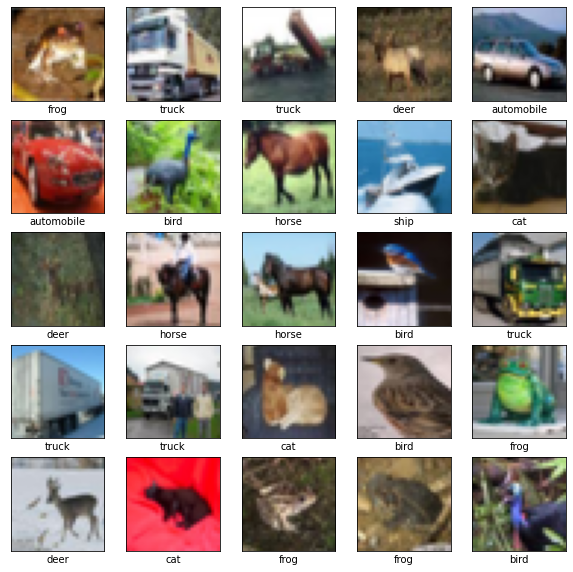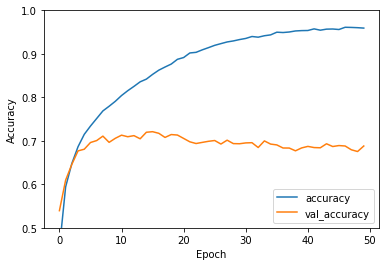Utilizzo l’environment conda py3_tf
1
| ~$ conda activate py3_tf
|
CIFAR-10 dataset
Verifichiamo che il setup di TensorFlow 2.2.0 sia andato a buon fine e facciamo qualche benchmark
Informazioni e download
Rinomimo il file scaricato in
‘cifar-10-batches-py.tar.gz’
Inserisco il file nella folder dataset di keras dell’environment py3_tf
‘/home/user/miniconda3/envs/py3_tf/lib/python3.7/site-packages/tensorflow/python/keras/datasets/cifar-10-batches-py.tar.gz’
..così si evita ogni volta che si lancia il codice di riscaricarlo
Locally
1
2
3
4
5
6
7
8
9
10
11
12
13
14
15
16
17
18
19
| ## HW Specs
print('GPU count and name')
!nvidia-smi -L
print('\nCPU model name')
!lscpu |grep 'Model name'
print('\nno.of sockets i.e available slots for physical processors')
!lscpu | grep 'Socket(s):'
print('\nno.of cores each processor')
!lscpu | grep 'Core(s) per socket:'
print('\nno.of threads each core')
!lscpu | grep 'Thread(s) per core'
print('\nCache')
!lscpu | grep "L3 cache"
print('\nCurrent frequency')
!lscpu | grep "MHz"
print('\nMemory')
!free -h --si | awk '/Mem:/{print $2}'
print('\nDisk space')
!df -h / | awk '{print $4}'
|
1
2
3
4
5
6
7
8
9
10
11
12
13
14
15
16
17
18
19
20
21
22
23
24
25
26
27
28
29
| GPU count and name
GPU 0: GeForce GTX 1050 Ti (UUID: GPU-85148f00-a065-c2dc-b2b8-90aefe5c4b79)
CPU model name
Model name: AMD Ryzen 5 1600 Six-Core Processor
no.of sockets i.e available slots for physical processors
Socket(s): 1
no.of cores each processor
Core(s) per socket: 6
no.of threads each core
Thread(s) per core: 2
Cache
L3 cache: 8192K
Current frequency
CPU MHz: 1709.295
CPU max MHz: 3200,0000
CPU min MHz: 1550,0000
Memory
16G
Disk space
Avail
53G
|
1
2
3
| ## controllo risorse GPU (pre-utilizzo)
!nvidia-smi
# watch -n 1 nvidia-smi
|
1
2
3
4
5
6
7
8
9
10
11
12
13
14
15
16
17
18
19
20
21
22
| Sat Jul 25 14:35:21 2020
+-----------------------------------------------------------------------------+
| NVIDIA-SMI 450.57 Driver Version: 450.57 CUDA Version: 11.0 |
|-------------------------------+----------------------+----------------------+
| GPU Name Persistence-M| Bus-Id Disp.A | Volatile Uncorr. ECC |
| Fan Temp Perf Pwr:Usage/Cap| Memory-Usage | GPU-Util Compute M. |
| | | MIG M. |
|===============================+======================+======================|
| 0 GeForce GTX 105... Off | 00000000:1C:00.0 On | N/A |
| 0% 51C P0 N/A / 72W | 249MiB / 4036MiB | 1% Default |
| | | N/A |
+-------------------------------+----------------------+----------------------+
+-----------------------------------------------------------------------------+
| Processes: |
| GPU GI CI PID Type Process name GPU Memory |
| ID ID Usage |
|=============================================================================|
| 0 N/A N/A 1213 G /usr/lib/xorg/Xorg 147MiB |
| 0 N/A N/A 1434 G /usr/bin/gnome-shell 55MiB |
| 0 N/A N/A 2276 G ...token=8304712969621933752 42MiB |
+-----------------------------------------------------------------------------+
|
1
2
3
4
5
6
7
| ## lib
# per lavorare solo in CPU
# import os
# os.environ['CUDA_VISIBLE_DEVICES'] = '-1'
import tensorflow as tf
from tensorflow.keras import datasets, layers, models
import matplotlib.pyplot as plt
|
1
2
| ## Verifico numero GPU
print("Num GPUs Available: ", len(tf.config.experimental.list_physical_devices('GPU')))
|
1
2
3
4
5
6
7
8
9
10
11
12
13
| ## (opzionale) Limito GPU (https://www.tensorflow.org/guide/gpu#limiting_gpu_memory_growth)
gpus = tf.config.experimental.list_physical_devices('GPU')
if gpus:
# Restrict TensorFlow to only allocate 1GB * 3 of memory on the first GPU
try:
tf.config.experimental.set_virtual_device_configuration(
gpus[0],
[tf.config.experimental.VirtualDeviceConfiguration(memory_limit=1024 * 3)])
logical_gpus = tf.config.experimental.list_logical_devices('GPU')
print(len(gpus), "Physical GPUs,", len(logical_gpus), "Logical GPUs")
except RuntimeError as e:
# Virtual devices must be set before GPUs have been initialized
print(e)
|
1
2
| ## Train and test nel mentre che scarichi il dataset (o trick descritto all'inizio per evitare di scaricarlo ogni volta)
(train_images, train_labels), (test_images, test_labels) = datasets.cifar10.load_data()
|
1
2
| ## Normalizza i valori dei pixel tra 0 e 1
train_images, test_images = train_images / 255.0, test_images / 255.0
|
1
2
3
4
5
6
7
8
9
10
11
12
13
14
| ## Verifiche del dato
class_names = ['airplane', 'automobile', 'bird', 'cat', 'deer',
'dog', 'frog', 'horse', 'ship', 'truck']
plt.figure(figsize=(10,10))
for i in range(25):
plt.subplot(5,5,i+1)
plt.xticks([])
plt.yticks([])
plt.grid(False)
plt.imshow(train_images[i], cmap=plt.cm.binary)
# The CIFAR labels happen to be arrays,
# which is why you need the extra index
plt.xlabel(class_names[train_labels[i][0]])
plt.show()
|

Prima di lanciare i comandi successivi è importante monitorare le risorse della CPU.
Ottenevo un errore di memoria che ho risolto limitando la CPU con i parametri descritti precedentemente.
1
2
| ## da terminale
~$ nvidia-smi
|
1
2
3
4
5
6
7
8
9
10
11
12
13
14
15
16
| ## Neural Networks
# Crea base convolutional
model = models.Sequential()
model.add(layers.Conv2D(32, (3, 3), activation='relu', input_shape=(32, 32, 3)))
model.add(layers.MaxPooling2D((2, 2)))
model.add(layers.Conv2D(64, (3, 3), activation='relu'))
model.add(layers.MaxPooling2D((2, 2)))
model.add(layers.Conv2D(64, (3, 3), activation='relu'))
# Architettura
# model.summary()
# Aggiungi il Dense layers on top
model.add(layers.Flatten())
model.add(layers.Dense(64, activation='relu'))
model.add(layers.Dense(10))
# Architettura completa
model.summary()
|
1
2
3
4
5
6
7
8
9
10
11
12
13
14
15
16
17
18
19
20
21
22
23
24
| Model: "sequential"
_________________________________________________________________
Layer (type) Output Shape Param #
=================================================================
conv2d (Conv2D) (None, 30, 30, 32) 896
_________________________________________________________________
max_pooling2d (MaxPooling2D) (None, 15, 15, 32) 0
_________________________________________________________________
conv2d_1 (Conv2D) (None, 13, 13, 64) 18496
_________________________________________________________________
max_pooling2d_1 (MaxPooling2 (None, 6, 6, 64) 0
_________________________________________________________________
conv2d_2 (Conv2D) (None, 4, 4, 64) 36928
_________________________________________________________________
flatten (Flatten) (None, 1024) 0
_________________________________________________________________
dense (Dense) (None, 64) 65600
_________________________________________________________________
dense_1 (Dense) (None, 10) 650
=================================================================
Total params: 122,570
Trainable params: 122,570
Non-trainable params: 0
_________________________________________________________________
|
1
2
3
4
5
6
7
| %%time
## Compila and addestra il modello
model.compile(optimizer='adam',
loss=tf.keras.losses.SparseCategoricalCrossentropy(from_logits=True),
metrics=['accuracy'])
history = model.fit(train_images, train_labels, epochs=5, verbose=0,
validation_data=(test_images, test_labels))
|
1
2
| CPU times: user 42.9 s, sys: 4.51 s, total: 47.4 s
Wall time: 30.7 s
|
1
2
3
4
5
6
7
| ## Valutazioni (il plot è su 50 epochs)
plt.plot(history.history['accuracy'], label='accuracy')
plt.plot(history.history['val_accuracy'], label = 'val_accuracy')
plt.xlabel('Epoch')
plt.ylabel('Accuracy')
plt.ylim([0.5, 1])
plt.legend(loc='lower right')
|

1
2
3
| ## accuracy
test_loss, test_acc = model.evaluate(test_images, test_labels, verbose=2)
print(test_acc)
|
1
2
| 313/313 - 1s - loss: 0.9358 - accuracy: 0.6775
0.6775000095367432
|
1
2
| ## controllo risorse GPU (post-utilizzo)
!nvidia-smi
|
1
2
3
4
5
6
7
8
9
10
11
12
13
14
15
16
17
18
19
20
21
22
23
| Sat Jul 25 14:59:16 2020
+-----------------------------------------------------------------------------+
| NVIDIA-SMI 450.57 Driver Version: 450.57 CUDA Version: 11.0 |
|-------------------------------+----------------------+----------------------+
| GPU Name Persistence-M| Bus-Id Disp.A | Volatile Uncorr. ECC |
| Fan Temp Perf Pwr:Usage/Cap| Memory-Usage | GPU-Util Compute M. |
| | | MIG M. |
|===============================+======================+======================|
| 0 GeForce GTX 105... Off | 00000000:1C:00.0 On | N/A |
| 0% 56C P0 N/A / 72W | 4016MiB / 4036MiB | 0% Default |
| | | N/A |
+-------------------------------+----------------------+----------------------+
+-----------------------------------------------------------------------------+
| Processes: |
| GPU GI CI PID Type Process name GPU Memory |
| ID ID Usage |
|=============================================================================|
| 0 N/A N/A 1213 G /usr/lib/xorg/Xorg 147MiB |
| 0 N/A N/A 1434 G /usr/bin/gnome-shell 69MiB |
| 0 N/A N/A 2276 G ...token=8304712969621933752 38MiB |
| 0 N/A N/A 29498 C ...a3/envs/py3_tf/bin/python 3755MiB |
+-----------------------------------------------------------------------------+
|
Google Colab
Enabling and testing the GPU
Prima di tutto bisogna abilitare la GPU:
- Navigate to Edit → Notebook Settings
- Seleziona GPU dal Hardware Accelerator drop-down
Note: ogni 12 ore circa il Disk, RAM, VRAM, CPU cache etc data verranno azzerati da questa macchina
1
2
3
4
5
6
7
8
9
10
11
12
13
14
15
16
17
18
19
| ## HW Specs
print('GPU count and name')
!nvidia-smi -L
print('\nCPU model name')
!lscpu |grep 'Model name'
print('\nno.of sockets i.e available slots for physical processors')
!lscpu | grep 'Socket(s):'
print('\nno.of cores each processor')
!lscpu | grep 'Core(s) per socket:'
print('\nno.of threads each core')
!lscpu | grep 'Thread(s) per core'
print('\nCache')
!lscpu | grep "L3 cache"
print('\nCurrent frequency')
!lscpu | grep "MHz"
print('\nMemory')
!free -h --si | awk '/Mem:/{print $2}'
print('\nDisk space')
!df -h / | awk '{print $4}'
|
1
2
3
4
5
6
7
8
9
10
11
12
13
14
15
16
17
18
19
20
21
22
23
24
25
26
27
| GPU count and name
GPU 0: Tesla T4 (UUID: GPU-e8f4bbb4-dc75-6911-be9c-2a94ff93e59f)
CPU model name
Model name: Intel(R) Xeon(R) CPU @ 2.00GHz
no.of sockets i.e available slots for physical processors
Socket(s): 1
no.of cores each processor
Core(s) per socket: 1
no.of threads each core
Thread(s) per core: 2
Cache
L3 cache: 39424K
Current frequency
CPU MHz: 2000.128
Memory
13G
Disk space
Avail
34G
|
1
2
| ## CLEAR ENVIRONMENT
!kill -9 -1
|
1
2
3
| ## TIME BENCHMARK
%%time
x = int(1e1)**int(1e7)
|
1
2
| CPU times: user 8.59 s, sys: 25.2 ms, total: 8.61 s
Wall time: 8.6 s
|
1
2
3
4
5
6
7
| ## VERIFICO SETUP
%tensorflow_version 2.x
import tensorflow as tf
device_name = tf.test.gpu_device_name()
if device_name != '/device:GPU:0':
raise SystemError('GPU device not found')
print('Found GPU at: {}'.format(device_name))
|
1
| Found GPU at: /device:GPU:0
|
1
2
| ## VERIFICO DISPONIBILITA' MEMORIA
!nvidia-smi
|
1
2
3
4
5
6
7
8
9
10
11
12
13
14
15
16
17
18
19
20
| Sat Jul 25 11:39:56 2020
+-----------------------------------------------------------------------------+
| NVIDIA-SMI 450.51.05 Driver Version: 418.67 CUDA Version: 10.1 |
|-------------------------------+----------------------+----------------------+
| GPU Name Persistence-M| Bus-Id Disp.A | Volatile Uncorr. ECC |
| Fan Temp Perf Pwr:Usage/Cap| Memory-Usage | GPU-Util Compute M. |
| | | MIG M. |
|===============================+======================+======================|
| 0 Tesla T4 Off | 00000000:00:04.0 Off | 0 |
| N/A 62C P0 31W / 70W | 219MiB / 15079MiB | 0% Default |
| | | ERR! |
+-------------------------------+----------------------+----------------------+
+-----------------------------------------------------------------------------+
| Processes: |
| GPU GI CI PID Type Process name GPU Memory |
| ID ID Usage |
|=============================================================================|
| No running processes found |
+-----------------------------------------------------------------------------+
|
1
2
3
4
5
6
7
8
9
10
11
12
13
14
15
16
17
18
19
20
| ## BENCHMARK -- PART 1
# lib
import tensorflow as tf
from tensorflow.keras import datasets, layers, models
import matplotlib.pyplot as plt
# Train and test
(train_images, train_labels), (test_images, test_labels) = datasets.cifar10.load_data()
# Normalizza i valori dei pixel tra 0 e 1
train_images, test_images = train_images / 255.0, test_images / 255.0
# Crea base convolutional
model = models.Sequential()
model.add(layers.Conv2D(32, (3, 3), activation='relu', input_shape=(32, 32, 3)))
model.add(layers.MaxPooling2D((2, 2)))
model.add(layers.Conv2D(64, (3, 3), activation='relu'))
model.add(layers.MaxPooling2D((2, 2)))
model.add(layers.Conv2D(64, (3, 3), activation='relu'))
# Aggiungi il Dense layers on top
model.add(layers.Flatten())
model.add(layers.Dense(64, activation='relu'))
model.add(layers.Dense(10))
|
1
2
| Downloading data from https://www.cs.toronto.edu/~kriz/cifar-10-python.tar.gz
170500096/170498071 [==============================] - 4s 0us/step
|
1
2
3
4
5
6
7
8
| ## BENCHMARK -- PART 2
%%time
# Compila and addestra il modello
model.compile(optimizer='adam',
loss=tf.keras.losses.SparseCategoricalCrossentropy(from_logits=True),
metrics=['accuracy'])
history = model.fit(train_images, train_labels, epochs=5, verbose=0,
validation_data=(test_images, test_labels))
|
1
2
| CPU times: user 27.5 s, sys: 3.23 s, total: 30.7 s
Wall time: 23.5 s
|
Benchmarks
CIFAR-10 dataset, Deep Neural Networks, 5 Epochs
- Locale Desktop: default GPU (verbose 1, 2 o 3 sono simili)
Epoch 5/5
1563/1563 [==============] - 8s 5ms/step - loss: 0.6739 - accuracy: 0.7649 - val_loss: 0.8258 - val_accuracy: 0.7148
CPU times: user 52.7 s, sys: 5.3 s, total: 58 s
Wall time: 38.7 s
note: GPU sta circa al 47% di utilizzo
- Locale Desktop: default GPU (no verbose)
CPU times: user 42 s, sys: 4.1 s, total: 46.1 s
Wall time: 28.9 s
note: GPU sta circa al 60% di utilizzo
- Locale Desktop: default CPU (no verbose)
CPU times: user 12min 24s, sys: 9.39 s, total: 12min 34s
Wall time: 1min 29s
note: tutti e 12 core stavano in media circa al 70% di utilizzo
- Google Colab: default GPU (verbose 1)
Epoch 5/5
1563/1563 [==============] - 6s 4ms/step - loss: 0.2377 - accuracy: 0.9148 - val_loss: 1.4661 - val_accuracy: 0.6927
CPU times: user 32.6 s, sys: 3.48 s, total: 36 s
Wall time: 29.2 s
- Google Colab: default GPU (no verbose)
CPU times: user 25.9 s, sys: 2.9 s, total: 28.8 s
Wall time: 21.3 s
- Google Colab: default CPU (no verbose)
CPU times: user 7min 50s, sys: 24.7 s, total: 8min 15s
Wall time: 4min 24s
- Locale Laptop: default CPU (no verbose)
Wall time: 7min 36s
%%time
x = int(1e1)**int(1e7)
- Locale Desktop: default CPU
CPU times: user 7.46 s, sys: 2.67 ms, total: 7.46 s
Wall time: 7.43 s
- Google Colab: default CPU
CPU times: user 8.78 s, sys: 20.3 ms, total: 8.8 s
Wall time: 8.78 s
note: in 5 lanci ha mostrato una discreta variabilità (circa +-3% secondi), è un processo single core
Altro
Wandb permette di monitorare le risorse, ma è complicato per quello che voglio e so fare.
GPUtil
GPU Usage: GPUtil.getGPUs()[0].load
VRAM Usage: GPUtil.getGPUs()[0].memoryUsed


